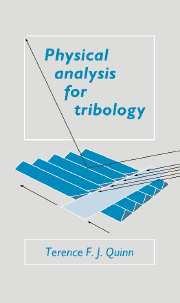Book contents
- Frontmatter
- Contents
- Preface
- Nomenclature list
- 1 Tribology
- 2 Macroscopic physical techniques
- 3 Microscopic physical techniques for studying atomic arrangement
- 4 Microscopic techniques for studying atomic structure
- 5 The analysis of lubricant films
- 6 The analysis of surface temperatures in tribo-systems
- 7 The analysis of pitting failures in tribo-systems
- 8 The analysis of oxidational wear in tribo-systems
- 9 The application of physical techniques to selected ceramic tribo-systems
- References
- Index
3 - Microscopic physical techniques for studying atomic arrangement
Published online by Cambridge University Press: 29 October 2009
- Frontmatter
- Contents
- Preface
- Nomenclature list
- 1 Tribology
- 2 Macroscopic physical techniques
- 3 Microscopic physical techniques for studying atomic arrangement
- 4 Microscopic techniques for studying atomic structure
- 5 The analysis of lubricant films
- 6 The analysis of surface temperatures in tribo-systems
- 7 The analysis of pitting failures in tribo-systems
- 8 The analysis of oxidational wear in tribo-systems
- 9 The application of physical techniques to selected ceramic tribo-systems
- References
- Index
Summary
Basic crystallography
Introduction
Most solid substances are polycrystalline, that is, they consist of many small regions of near-perfect simple crystals (crystallites) which are generally oriented at random with respect to each other. Sometimes, however, these crystallites have preferred orientations with respect to each other. The facility for taking up preferred orientations can be a distinct advantage in metal-forming operations. It is also partly responsible for the successful operation of carbon brushes (as we shall see in Chapter 5). Separating the crystallites there are regions of very poor crystallinity, that is the atoms in these regions are not arranged in the regular arrays expected of a perfect single crystal. These regions are called ‘grain boundaries’ and they have a strong influence upon the mechanical strength of a polycrystalline solid. It is generally assumed that polycrystalline solids are isotropic as regards mechanical strength, electrical and thermal conductivity, and other physical properties relevant to the friction and wear of such solids. We shall see, however, that this assumption is not valid for materials which take up a preferred orientation upon interacting with another surface during motion. It is also not true in respect of materials that change the chemical composition of their interacting surfaces during contact, especially those materials that exhibit mild (oxidational) wear.
- Type
- Chapter
- Information
- Physical Analysis for Tribology , pp. 82 - 147Publisher: Cambridge University PressPrint publication year: 1991



